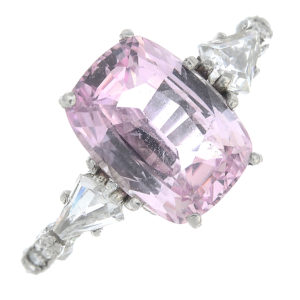Lot 276 in the March Fine Jewellery auction is this padparadscha sapphire. Nicola Whittaker, Business Development Manager at Fellows, has explored the history behind this beautiful piece.
The Padparadscha is a very special cousin to the more commonly found blue sapphire. This pinkish orange stone is rare due to its unusual colour and limited locale, Sri Lanka. Although pinkish orange sapphires have been found in Madagascar, they are often heavily treated to achieve the same colour as one from Sri Lanka and most experts will only attribute the “padparadscha” name to a Sri Lankan stone.
The name “padparadscha” comes from Sinhalese, meaning lotus blossom coloured. While the most perfect gem quality stone would be fully saturated medium pinkish orange, most laboratories will certify Padpradscha stones from light pinkish orange to medium orangish pink. Due to the light colour of these stones, the clarity is particularly important as inclusions are more obvious.
 A Sri Lankan padparadscha sapphire ring, with modified kite-shape diamond shoulders and rose-cut diamond gallery.
A Sri Lankan padparadscha sapphire ring, with modified kite-shape diamond shoulders and rose-cut diamond gallery.
Like other sapphires, padparadscha sapphires can be heated to improve the colour of the stone. As such an unheated padparadscha sapphires command a premium at auction. It is rare to find good-quality padparadschas of more than two carats, and any stone above five carats is considered a world-class gem. The world’s largest known gem quality padparadscha sapphire is the 100.18ct one on display at the American Museum of Natural History in New York.
Along with rubies and other coloured sapphires, padpradscha sapphires are part of the corundum family. This means that they are rated as “9” on the Mohs scale of hardness and can be worn as rings without risk of major abrasion. The most recent celebrity spotted wearing a padparadscha sapphire is HRH Princess Eugenie. Her enagement ring is a padpadrascha sapphire and diamond cluster with round brilliant cut diamonds and two pear shaped diamonds on the shoulder on a yellow gold band.
 A Sri Lankan padparadscha sapphire ring, with modified kite-shape diamond shoulders and rose-cut diamond gallery.
A Sri Lankan padparadscha sapphire ring, with modified kite-shape diamond shoulders and rose-cut diamond gallery. A Sri Lankan padparadscha sapphire ring, with modified kite-shape diamond shoulders and rose-cut diamond gallery.
A Sri Lankan padparadscha sapphire ring, with modified kite-shape diamond shoulders and rose-cut diamond gallery.











